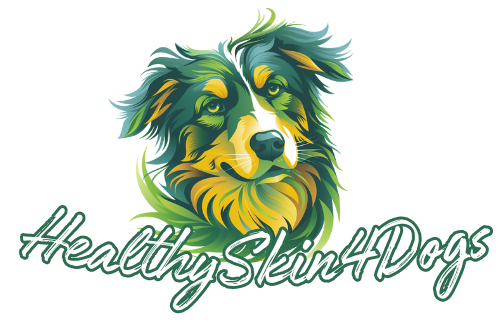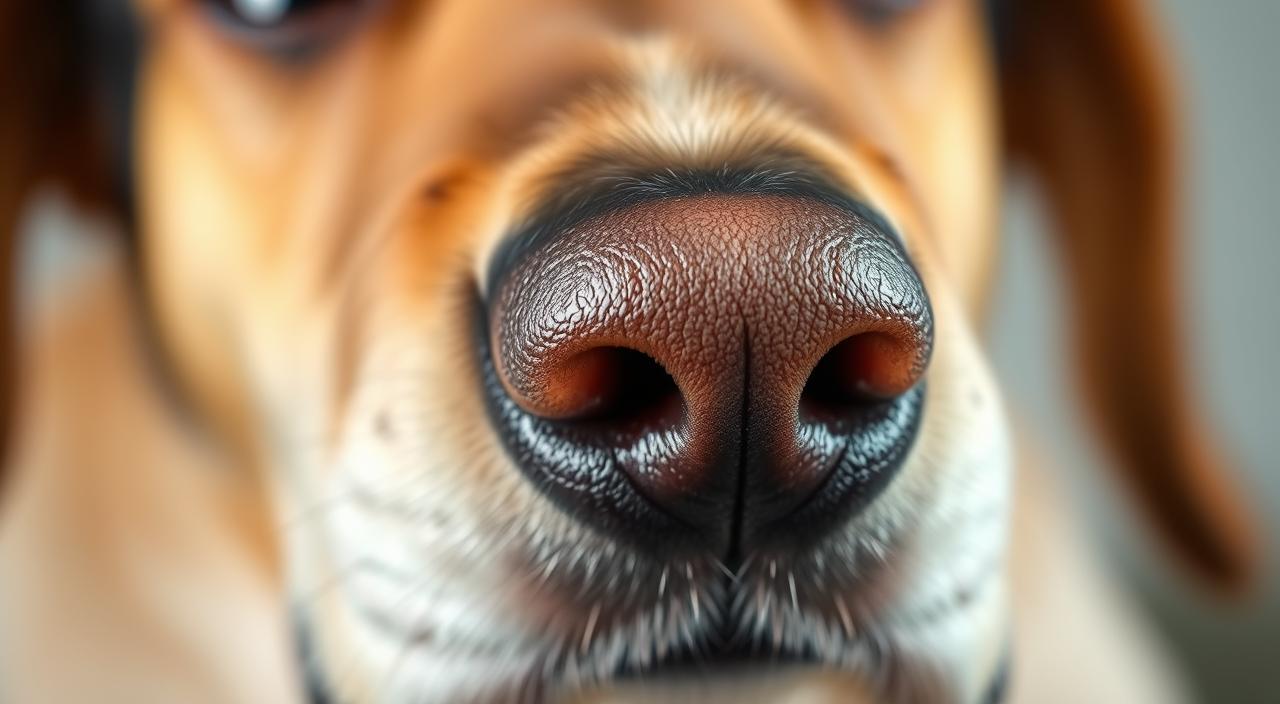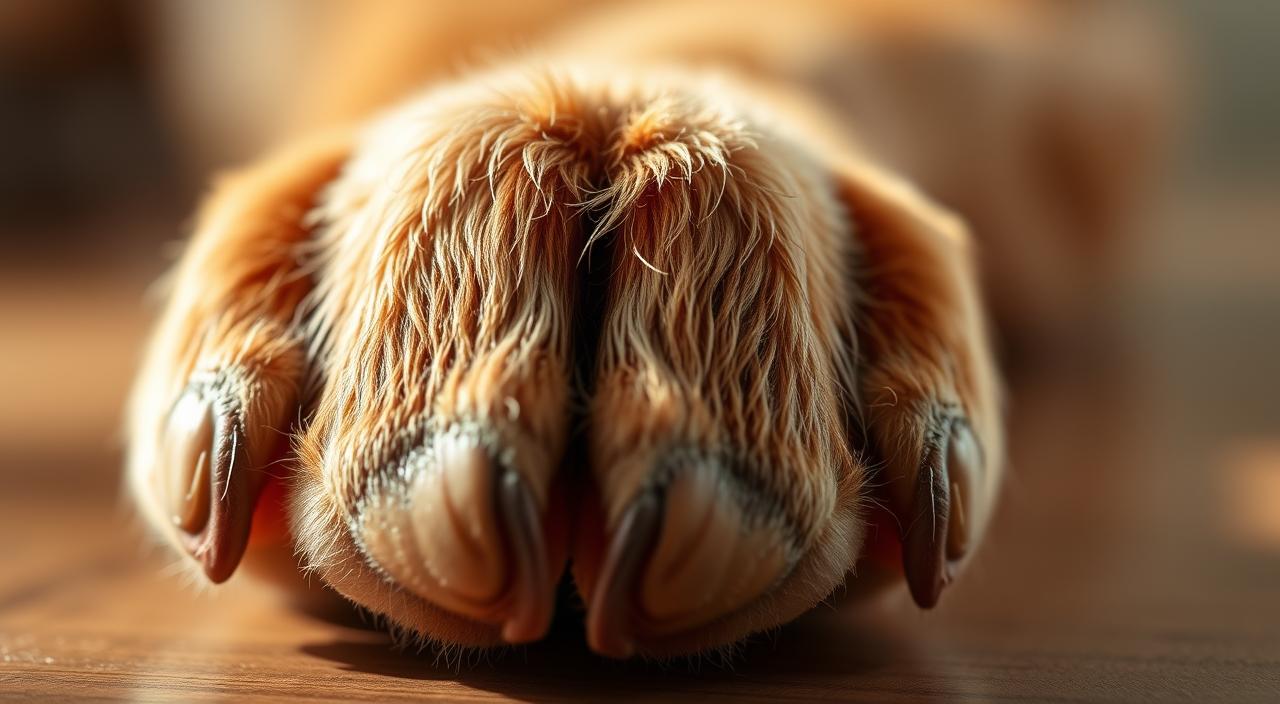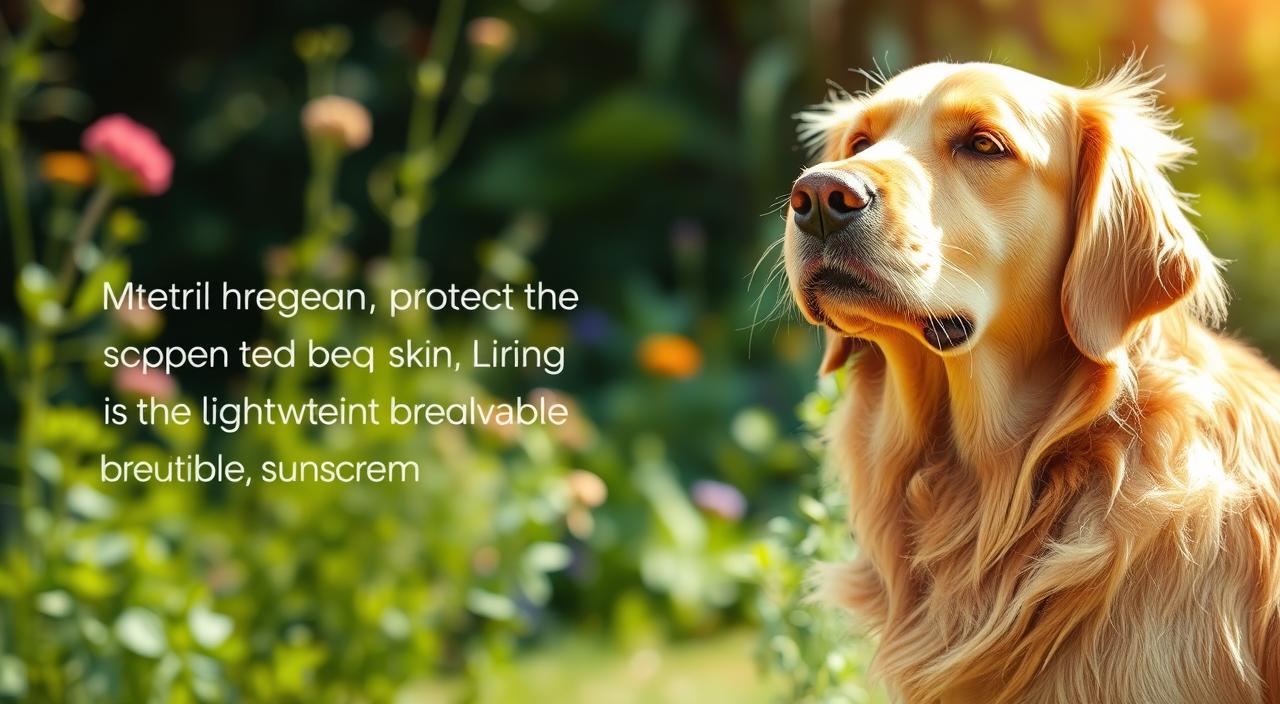You may worry when your pet has a dry nose in dogs causes you to stop and check for signs of illness, but a warm, tacky snout is not always a red flag.
A dog’s snout helps cool the body, drains tears through tiny ducts, and moves scent particles to receptors via licking. Simple shifts — sleep, sun exposure, or low humidity — often explain changes, while some medical conditions need lab tests or biopsy to diagnose.
Brachycephalic breeds can struggle to lick well and may build crusts. Autoimmune problems like lupus or pemphigus can crack or bleed the skin and usually require immunosuppressive treatment under veterinary care.
Avoid over-the-counter human lotions; pets groom themselves and can ingest unsafe products. Learn your pet’s normal baseline and watch for other signs — appetite, energy, breathing — to know when an exam is wise.
Key Takeaways
- One touch isn’t a diagnosis: context and overall health matter more than a single test.
- The snout supports cooling, tear drainage, and scent work — changes can reflect broader health.
- Warm and tacky does not always equal illness; observe behavior and other symptoms.
- Brachycephalic breeds and autoimmune disorders need special attention and vet diagnostics.
- Avoid human creams; use pet-safe balms only if a veterinarian recommends them.
What a healthy dog nose feels like and why it matters
A healthy dog’s snout can feel cool and moist one moment, then warm and slightly tacky the next. Owners should learn their pet’s baseline so small changes are easier to spot.
How dogs keep their noses wet: mucus, licking, and tear ducts
Moisture comes from tiny mucus glands inside the nasal passages. That mucus moves to the surface and helps keep scent particles active.
Dogs also lick noses to spread moisture and refresh scent receptors. Tear ducts drain into the nasal area and add to the wetness you feel.
Warm, dry vs. cold, wet: what’s normal over the course of a day
A cool, wet face is common, but brief warm or drier periods often follow sleep, sun exposure, or a change in humidity. Evaporation from the nasal surface also helps regulate body temperature—similar to light sweating.
- Baseline: a healthy dog often has a moist dog nose, but levels vary across the day.
- Form and function: a wet surface traps odors and supports strong scent detection.
- Quick check: if the snout seems drier than usual, review energy, appetite, and hydration before assuming illness.
- Myth: a mean dog “sick test” by touch is unreliable; fever can show with either a dry or runny surface.
Note subtle patterns—tracking sleep, activity, weather, or indoor heat helps explain short-term shifts. Persistent dryness, pain, or other signs should prompt veterinary evaluation.
dry nose in dogs causes
Several common problems can make a dog’s snout feel less moist, and knowing each one helps owners respond quickly.
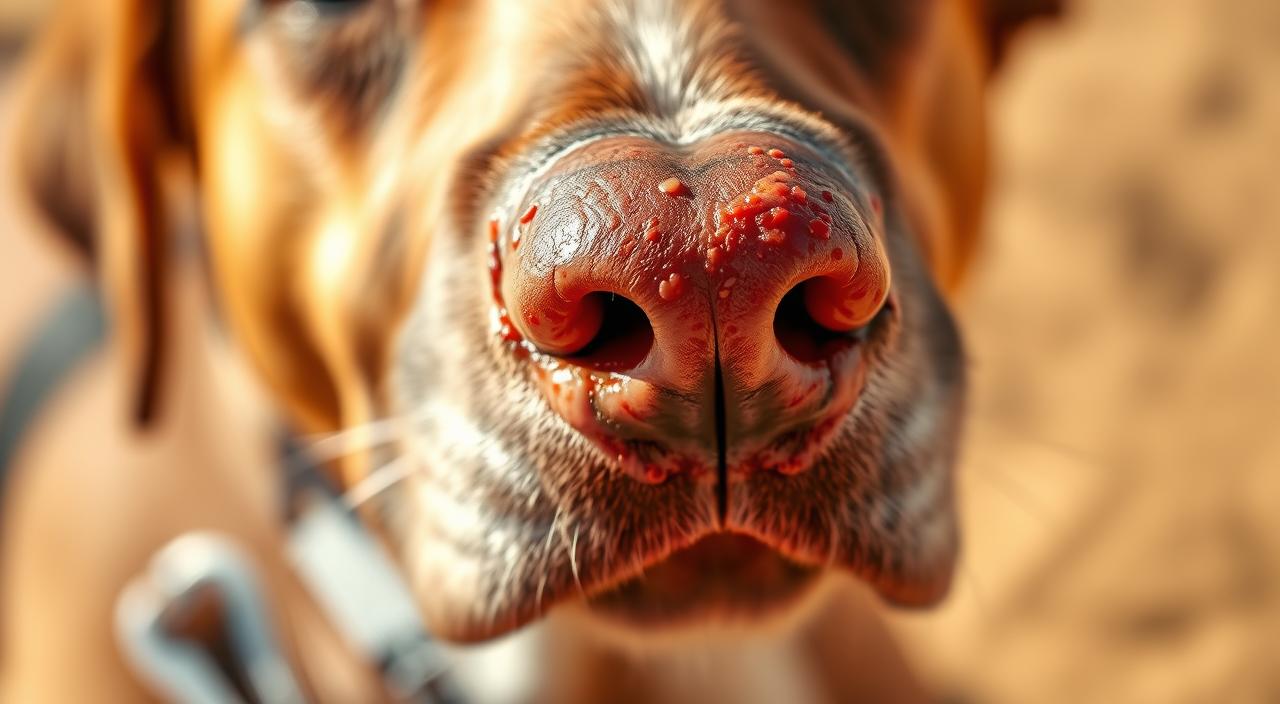
- Sunburn: Pink or lightly pigmented snouts can burn. Look for redness, soreness, cracking, or peeling; shade and pet-safe sunscreen protect vulnerable skin.
- Dehydration: After hard exercise or heat exposure a dog may show lethargy and poor skin elasticity. Offer cool water and rest; severe cases need veterinary attention.
- Fever or elevated temperature: High body heat can reduce surface moisture. Because fever may occur with either a wet or less wet snout, watch energy and appetite rather than touch alone.
- Allergies: Environmental or food allergens cause itching, rubbing, and irritation. Persistent irritation or sneezing merits a vet consult.
- Autoimmune skin disorders: Conditions like discoid lupus or pemphigus change texture, cause ulceration or bleeding, and usually require biopsy and targeted treatment.
- Brachycephalic breeds and hyperkeratosis: Short-faced breeds often struggle to lick noses. Over time chalky buildup and cracking may develop and need ongoing care.
- Sleeping or downtime: Dogs don’t lick snouts while napping, so brief post-nap dryness is common and usually clears when they wake and lick again.
- Low humidity or indoor heat: Dry air from heaters and arid climates can chap the surface; adding a humidifier often helps.
- Dry eye or tear duct problems: Reduced tear flow or blocked drainage can cause persistent or one-sided dryness and won’t improve with drinking alone—veterinary evaluation is advised.
Practical cue: note timing and breed traits—after sun, exercise, or naps—and any other symptoms to help a clinician pinpoint the correct condition and next steps.
Signs to watch beyond a dry dog nose
Watch for changes beyond a simple surface shift—some signs point to a mild irritation, while others need prompt care.
Changes in texture or color: crusting, peeling, loss of cobblestone look
Surface changes such as cracking, crusts, bleeding, or peeling suggest more than a brief episode. Loss of the usual bumpy texture should be noted and photographed with dates to track progression.
Systemic symptoms: lethargy, appetite loss, coughing, sneezing
If a dog shows low energy, reduced eating, persistent coughing, or frequent sneezing alongside a rough patch, this raises concern for a broader health issue. Check gums and skin turgor for hydration clues.
Nasal discharge, runny nose, or one-sided dryness
A runny nose, thick discharge, or moisture on only one side can point to local infection, nerve-related tear problems, or blocked ducts. Unilateral changes often need veterinary evaluation.
- When to act: if any sign lasts more than 48 hours or the pet seems unwell, schedule a clinic visit.
- Reassurance: brief, mild changes after sleep or sun exposure with normal behavior usually warrant simple observation.
What you can do at home and when to try simple care
Owners can usually treat brief surface irritation at home with hydration, shade, and gentle moisturizers. Start with basics and watch for steady improvement over a few days.
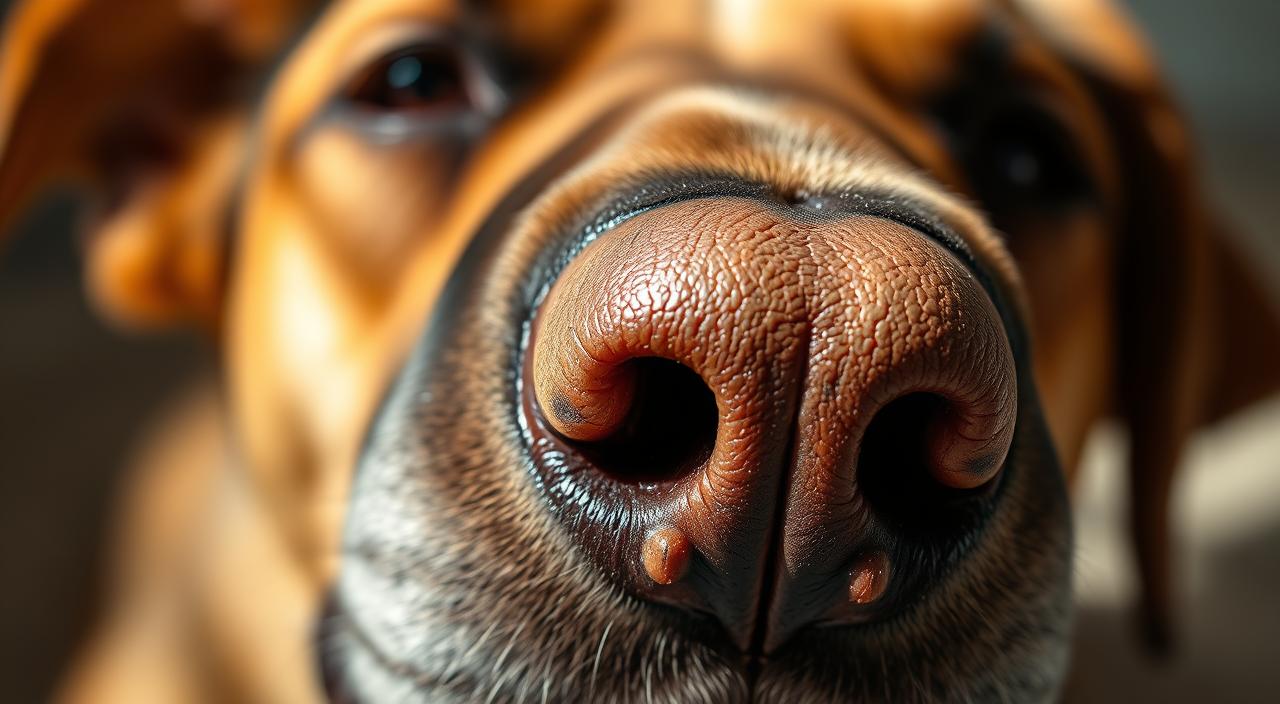
Hydration, shade, and humidity: quick relief for environmental dryness
After heavy exercise, offer fresh water and a cool rest spot. Mild dehydration from exertion often resolves with fluids and rest.
Use a humidifier during dry months and limit direct heater exposure. Provide shade outdoors and consider dog-friendly sunscreen for fair-skinned pups to prevent sunburn.
Soothing the skin safely: pet-formulated balms and what to avoid
Gently wipe crusts with a damp cloth before applying a balm. Pet products like Snout Soother or Dermoscent BIO BALM soften rough patches and support barrier health.
A small amount of Aquaphor can help; rub it in well and avoid flavored or medicated human creams unless a veterinarian approves. Monitor for swallowing or blocked nostrils.
- Start with water, rest, and a cool spot for faster return to a wet nose.
- Apply pet-safe balms sparingly; clean first for better absorption.
- Seek treatment if bleeding, deep cracks, or a persistent crust appear.
| Home Measure | When to Use | Cautions |
|---|---|---|
| Fresh water & rest | After exercise or heat | Watch for persistent dehydration |
| Humidifier & shade | Dry seasons, heater use | Avoid mold; clean humidifier regularly |
| Pet-formulated balm | Thick, flaky skin | Do not use flavored human lotions |
When to call the vet and what to expect at the appointment
If changes last more than 48 hours or the pet seems unwell, book an appointment with your veterinarian. Severe dehydration, painful cracking, bleeding, one-sided wet or runny nose, or a sudden color shift are clear signs to get professional help.
Diagnostics and treatment options: exams, lab work, and possible biopsy
At the clinic the vet will perform a full physical exam and check hydration, temperature, and general health. Tear production tests and a mouth-and-eye check help rule out dry eye or tear-duct problems.
- Bring timing notes, photos, and a list of products tried to the appointment — this saves time and helps the clinician link symptoms to likely conditions.
- Blood and urine tests screen for systemic disorders; allergy testing or topical cultures may follow if infection or allergy is suspected.
- If autoimmune disease is likely, a small nasal biopsy under anesthesia may be needed to confirm the diagnosis; treatment often involves immunosuppressive therapy.
| Test | Why it’s done | What to expect |
|---|---|---|
| Blood/urine | Check systemic health | Routine sample at visit |
| Tear production test | Assess dry eye | Quick clinic test |
| Biopsy | Confirm autoimmune or cancer | Minor procedure under anesthesia |
Animal hospital staff will recommend pet-safe products because animals lick their snout. For persistent or recurrent issues, plan follow-up visits so the care team can adjust treatment and monitor healing.
Conclusion
Brief surface changes usually resolve with simple care: water, shade, and added humidity often help a dog return to a nose wet baseline within a short time. Most shifts relate to sleep, sun, or indoor heat rather than serious illness, and many dogs get back to normal fast.
If a change lasts beyond 48 hours or includes bleeding, deep cracking, one-sided symptoms, or low energy, contact your vet or schedule a veterinarian visit. These signs may point to a different cause that needs testing or treatment.
Track patterns, take photos, and note appetite and breathing before your appointment—this saves time. With a calm approach and timely vet checks, most concerns are manageable and your pet’s comfort and long-term health are easier to protect.
